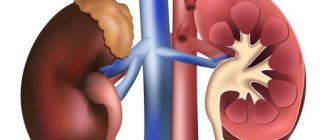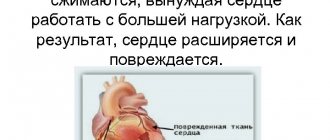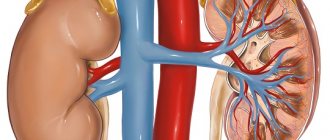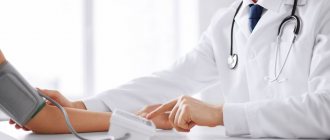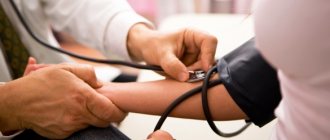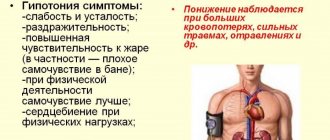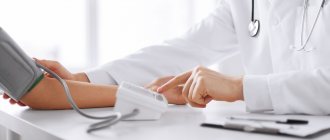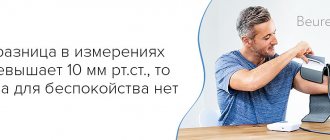The blood pressure value is expressed in two numbers. The first indicator is systolic pressure, which is popularly called upper, the second is diastolic, or lower. Systolic shows the level of blood pressure when the heart contracts, diastolic - at the moment of its relaxation.
Normally, blood pressure should not exceed 120/80 mm Hg. pillar If it is between 120/80 and 139/89, we are talking about prehypertension, higher values indicate hypertension, or hypertension. Most often, with elevated blood pressure, both indicators exceed the norm. A more rare occurrence is high lower blood pressure with normal upper blood pressure.
What is diastolic pressure?
It means the degree of blood pressure on the vascular walls at the moment of relaxation of the heart muscle, when there is little blood in it. This indicator gives an idea of the tone of the vascular walls, since diastolic pressure is a reaction to their resistance. Lower blood pressure is considered normal if it is below 80 mm Hg. pillar
A sustained increase in diastolic blood pressure indicates a high resistance of the vascular walls, which means their constant spasm. If the vessels are always narrowed, blood flows poorly to the organs and tissues and they do not receive enough oxygen and nutrients. This leads to disruption of organ function.
There are three stages of isolated increase in lower blood pressure:
- 1st – 90-100 mm Hg. Art.;
- 2nd – 100-110;
- 3rd - above 110.
Forecast
High blood pressure can lead to several complications. According to the AHA, the following complications may occur when high blood pressure is uncontrolled:
- stroke
- heart disease
- angina pectoris
- heart failure
- peripheral artery disease (PAD)
- vision loss
- sexual dysfunction
- kidney disease or failure
To control your high blood pressure at home, you can take several of the steps listed above. Taking these measures may reduce your risk of serious complications.
If you have high blood pressure, you need to monitor your readings at home. You should also check your health regularly with your doctor.
If your efforts to lower your blood pressure are unsuccessful, you should talk to your doctor about other strategies you can try.
Causes of increased diastolic pressure
Hypertension can be primary, that is, it is unknown why blood pressure has risen, and secondary (symptomatic), if it develops against the background of other diseases. Why does diastolic blood pressure increase?
Causes of isolated increase in lower blood pressure
If lower pressure is elevated for a long time, the reasons may be the following:
- Kidney disorders. The kidneys are one of the main organs involved in regulating blood pressure. The cause of increased diastolic blood pressure may be a narrowing of the renal artery, in which the volume of blood entering the kidneys decreases. An increase in blood pressure with a predominant increase in diastolic is observed in chronic glomerulonephritis, congenital anomalies in the structure of the renal vessels, and renal failure.
- Thyroid diseases.
- Cardiac pathologies: heart defects, tumor processes.
- Diseases of the adrenal glands and pituitary gland.
- Spinal hernias.
- Changes in hormonal balance, for example in women during pregnancy.
The kidneys are directly involved in regulating blood pressure. If their work is disrupted, the pressure deviates from the norm
Reasons for increasing lower blood pressure simultaneously with upper blood pressure
- Increased lower pressure is usually observed in essential hypertension, which is also called essential hypertension (HD) or primary hypertension. The reasons for the increase in pressure in this case have not been established and it is in no way related to other pathologies. Hypertension with high diastolic pressure is more often observed in young people and can progress and take a malignant course. With this disease there is a high probability of developing complications, and the higher the pressure, the greater the risk.
- Lower pressure can change throughout the day in healthy people, for example, it can increase during emotional or physical stress. As a rule, it quickly decreases on its own, and this is considered normal.
- Excessive alcohol consumption.
Lower pressure 90 - is this normal?
Every person should have a blood pressure monitor in their first aid kit. If there is no one in the family who could manually inflate the cuff with a bulb and determine the pressure parameters by the movement of the arrow, you can buy an automatic device. It is not much more expensive, and in addition to pressure, it also counts the pulse and can determine signs of arrhythmia. Feeling unwell for no apparent reason should be a reason to measure your blood pressure.
The optimal indicators are considered to be a pair of systolic and diastolic pressures of 120/70 Hg, but even if these numbers rise to 130/80 Hg, this will be considered normal. Values of 140/90 Hg and above are considered elevated. With these values, the doctor can already diagnose arterial hypertension and prescribe a course of treatment.
A lower pressure of 90 units indicates the onset of hypertension. Such values can also appear at a young age, so not only older people need to monitor their blood pressure. Young people have a higher tendency to identify chronic pathologies, which are often accompanied by associated complications.
Danger
An increase in lower pressure often has no symptoms, and a person does not even know about it. They may be discovered during a routine examination or when visiting a doctor for other reasons. There is a misconception that only elevated upper blood pressure threatens health and life, but in fact, an increase in lower blood pressure is no less dangerous. The heart in this state is constantly tense and practically does not relax. The blood flow in it is disrupted, the disease progresses, structural changes begin to occur, which ultimately become irreversible.
It is important to know that high lower blood pressure cannot be ignored. It leads to organ dysfunction and, without treatment, can result in death within six months. There is a high risk of developing thrombosis, heart attacks, and strokes.
When to see a doctor
Measuring your blood pressure is the only way to determine if it is high. You can visit your doctor to monitor your blood pressure regularly. You can also ask your doctor to show you how to properly measure your blood pressure at home yourself.
People at risk of developing high blood pressure should have regular medical checkups and monitor their blood pressure at home.
If you have high blood pressure and your efforts to lower your blood pressure are not effective, you should also contact your doctor.
Treatment
Treatment should be carried out only under the supervision of a doctor. You should not do this yourself. First of all, you need to find out the reasons for the increase in lower blood pressure. If hypertension is secondary, treatment of the primary pathology is required. In any case, it is necessary to reduce the pressure, for which a set of measures is used, including:
- proper nutrition;
- loss of excess weight (if any);
- compliance with the daily routine (work and rest);
- physical activity (sports, physical therapy, walking);
- staying in the fresh air;
- taking medications;
- folk remedies.
Diet
Proper nutrition is of great importance for normalizing blood pressure. The diet should consist of:
- Fresh vegetables, herbs, berries and fruits.
- Lean meats.
- Dairy and fermented milk products.
- Lean fish.
- Bread made from wholemeal flour.
- Replace sugar with honey.
The following foods should be limited or avoided:
- salty (salt retains fluid in the body, which increases blood pressure);
- fatty and fried;
- sweet and buttery;
- alcoholic drinks.
All people with hypertension should limit salt in their diet
Medicines
You should only take medications prescribed by your doctor. Typically, medications from several groups are used to normalize blood pressure, including:
- Beta blockers are drugs that reduce the heart's need for oxygen, regulate its functioning and lower blood pressure.
- Calcium antagonists - increase the activity of renin, which is poorly produced in renal pathologies. Prescribed in severe stages of hypertension, for example, in renal failure, after heart attacks to prevent death.
- Diuretics (diuretics).
Traditional methods
Traditional medicine offers many remedies to lower diastolic blood pressure, but they should only be taken with the permission of a doctor. As a rule, these are decoctions and infusions that reduce nervous tension, help you relax and calm down.
Hawthorn
An infusion of the fruits of this plant relaxes vascular walls and relieves nervous excitability. A glass of water will require 20 grams of dry fruits. Boil for 30 minutes, then strain and add water to the original volume. Take a tablespoon three times a day.
Traditional medicine suggests treating hypertension with a decoction of hawthorn fruits
Motherwort
The infusion increases the strength of heart contractions, calms the nerves, and eliminates overexcitation. Two tables. Pour a spoonful of herbs into a glass of hot water and leave for an hour. Drink two per table. spoons every day before bed.
Diuretic collection
Pour a mixture of herbs (a tablespoon each of St. John's wort, oregano, motherwort and sage) with boiling water (two glasses) and leave for half an hour. Drink half a glass a day for a month.
Valerian
It has a relaxing effect on the central nervous system and helps lower blood pressure.
Peony
Pharmacy tincture from herbs and peony roots eliminates muscle spasms and has a calming effect.
Cedar cones
Tincture of pine cones helps lower blood pressure. To prepare, you need to take three whole cones, put them in a glass jar and fill them with vodka (1/2 liter), add ten pieces of sugar, a tablespoon of valerian tincture purchased at the pharmacy and leave for 10 days in a dark place. Strain and drink a tablespoon before bed. You can fill the cones two more times.
Beet
Freshly squeezed beet juice strengthens vascular walls and is used to lower blood pressure. You need to take two teaspoons of juice daily half an hour before meals.
How and with what is high blood pressure treated?
Pharmacists offer a range of effective antihypertensive drugs that not only reduce blood pressure, but also protect the heart, blood vessels, kidneys and brain suffering from high levels. A wide variety of pharmaceuticals of different classes allows doctors to select the optimal treatment regimen for a particular patient.
Self-administration of antihypertensive medications is strictly prohibited. After all, when prescribing medications and choosing their dosage, not only blood pressure indicators and the patient’s age are taken into account, but also the data of his laboratory tests and the presence of concomitant diseases. Therapy with modern drugs is lifelong and has several significant features.
- As a rule, several drugs are prescribed at once, acting effectively in combination.
- There is still an opinion among people that they should be taken only when blood pressure levels are elevated, and that when blood pressure levels are normal, they can be skipped. This approach completely eliminates the ongoing therapy. Blood pressure medications should be taken even on days when the patient feels well. After all, the indicators normalized as a result of treatment will immediately jump when the active substances of the medicinal formulas are completely removed from the body.
Diagnostics
If a patient has a lower pressure of 100, then you need to determine what this means in a particular case.
To do this, you need to undergo a comprehensive diagnosis:
- biochemical and general blood test;
- ultrasonography;
- dopplerography of the head;
- ECG.
When the heart pressure reaches 100, the heart hurts; It is customary not to take medications for systematic treatment without consulting a doctor, but to track the values throughout the day and write them down in a notebook.
The dynamics of changes in indicators will be assessed by a qualified specialist.
Tips to normalize cardiac blood pressure
There are folk recipes and recommendations that will help reduce lower pressure if it reaches 100 or more.
How to reduce blood pressure, we will consider below:
- Corn flour tincture helps effectively. In the evening, pour a spoonful of this flour into a glass and fill it with hot water. The product should be infused overnight, after which it is filtered and taken throughout the day.
- Every day before meals you can eat a couple of cloves of garlic. You can lower blood pressure by taking a tincture of this ingredient. Pour boiling water over the garlic and leave for 6 hours. The finished medicine is filtered and stored in the refrigerator.
- Cranberry juice can reduce blood pressure readings. For greater effectiveness, it is recommended to mix it with flower honey, maintaining a 1 to 1 ratio. The course of treatment is two weeks, provided that the medicine is taken a teaspoon three times a day.
- A decrease in blood pressure occurs if you take a mixture of onions and honey. The proportions of ingredients and dosage are the same.
Elecampane is useful for hypertensive patients. By lowering pressure, it strengthens the walls of blood vessels and the myocardium. You will need the following ingredients: dried plant root, washed oats, honey.
The medicine is prepared according to the following algorithm:
- pour oats with water (500 ml), boil, leave for a couple of hours;
- dried plant roots (70 g) are crushed, poured with pre-settled decoction and boiled again;
- the prepared product is infused for another two hours;
- after straining, add honey, mix and drink three times a day before meals (the duration of the therapeutic course is on average two weeks).
Using these simple recommendations, you can keep your problematic blood pressure normal. If you take the medication daily, you won’t have to worry about the consequences of sudden surges in blood pressure.
Symptoms
With cardiac hypertension at the initial stage, symptoms are practically not expressed, so it is difficult to notice the disease with the naked eye.
The symptomatic picture with increased diastolic pressure is similar in its symptoms to ordinary fatigue. During an attack, the patient has:
- slight loss of strength;
- mild headache;
- mild dizziness;
- during critical surges - nausea and vomiting.
Most often, hypertension is detected during the diagnosis of other diseases. This is due to the fact that the symptoms of cardiac hypertension are not pronounced and the patient does not have specific complaints that would indicate the development of the disease.
